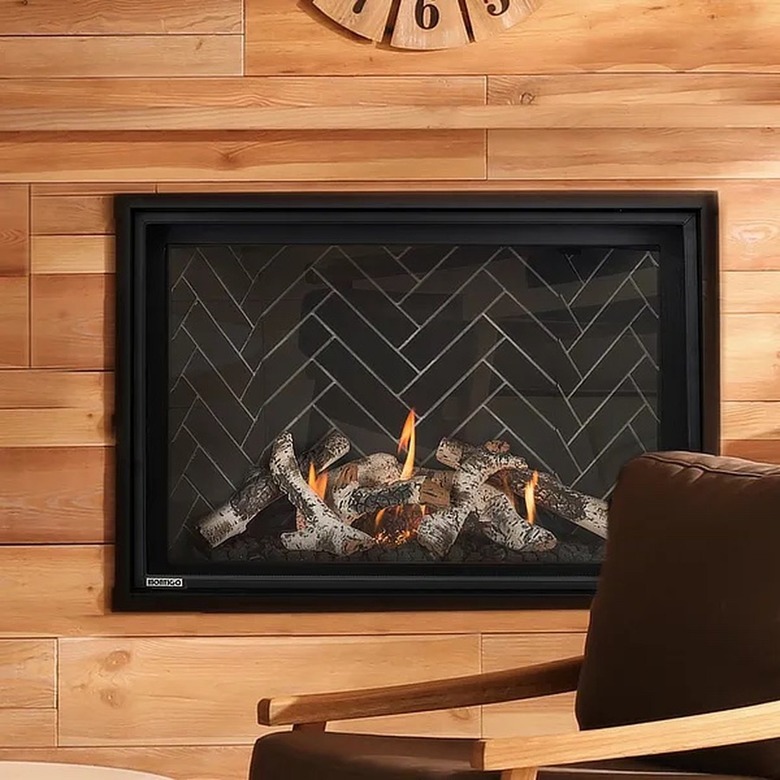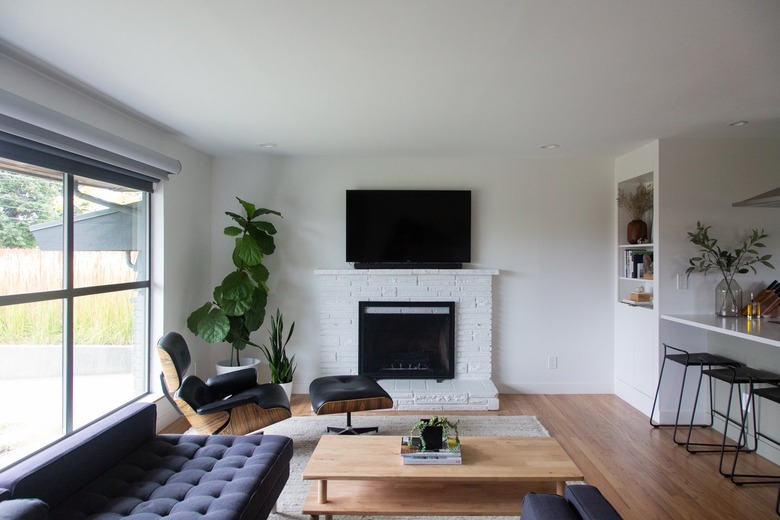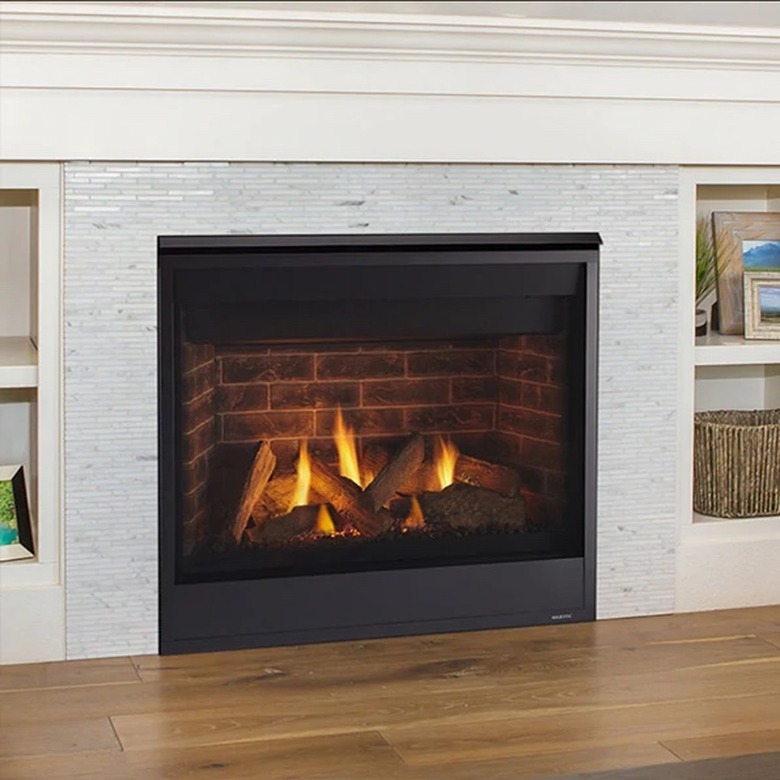The 7 Advantages Of A Direct Vent Gas Fireplace
We may receive a commission on purchases made from links.
Homeowners who are considering installing a new direct vent gas fireplace will probably want to know how this type of gas fireplace stacks up against the alternatives: a B-vent, vent-free gas fireplace, or gas fireplace insert. Once you know how these different types of fireplaces work, you'll be in a better position to appreciate the advantages of a direct vent gas fireplace, which are many.
If you're in the market for a gas fireplace, it may be because you already have a wood-burning fireplace but prefer the convenience and cleanliness of heating with gas. It takes a lot of work to maintain wood fireplaces not to mention acquiring and storing the wood. On the other hand, you may not already have a fireplace, and you're looking for a bit of ambiance for your living room or bedroom as well as a source of extra heat. In either case, a direct vent fireplace is a good choice.
You could also go with an electric fireplace, and because it's easy to install and maintain, it's a realistic option. One of the main advantages of electric fireplaces is that you never have to worry about combustion gases and their effect on indoor air quality, and no vent is required at all. However, you have to be prepared for a higher energy bill — and besides, there's nothing like a burning flame to make a room feel cozy and comfortable.
So, if your heart is set on natural gas or propane as an energy source, you'll want to consider seven reasons for opting for a direct vent fireplace over the other two types.
Direct Venting vs. Other Venting Options
Direct Venting vs. Other Venting Options
Any fireplace that uses propane or natural gas as a fuel source needs a way to get air for combustion and a way to deal with the toxic fumes. Both direct vent and B-vent systems handle the problem of combustion gases with a venting system that exhausts them outdoors, while ventless fireplaces handle it by making combustion so complete that there are hardly any gases to exhaust. The three systems work in the following ways:
- B-vent fireplaces work like traditional fireplaces, and they need a vertical chimney pipe to work properly. The heat created by the fire creates an updraft that draws air through the flue and disperses it outside, and that in turn creates negative pressure around the fire that draws combustion air from the room. For this reason, the flame of a B-vent fireplace has to be exposed to the room.
- Direct vent fireplaces also exhaust air through a flue or vent pipe, but they are designed to also bring outside air into the firebox to fuel combustion rather than pulling it from the room. Because it doesn't use any indoor air, a direct vent fireplace can be sealed in a special glass enclosure. Also, because a direct vent fireplace doesn't have to create an updraft to work properly, the flue doesn't have to run vertically and can be directed through a wall.
- A vent-free or ventless fireplace, like a direct vent one, is also completely sealed by fire glass, and it's engineered to recycle combustion gases in much the same way a high-efficiency furnace burns them to extract extra heat. It draws air for combustion from indoors, and it releases the few gases left over after combustion and re-combustion — which are mostly carbon dioxide and water vapor — back into the room in which it's situated. Because of the possibility of increased humidity and harmful residuals, such as carbon monoxide, being exhausted into the indoor air and affecting air quality, ventless fireplaces are highly regulated or prohibited in some states.
The Advantages of a Direct Vent Gas Fireplace
The Advantages of a Direct Vent Gas Fireplace
In terms of combustion and heat production, a ventless fireplace insert is the most energy-efficient type of gas fireplace, operating at close to 100 percent efficiency as opposed to 70 percent for direct vent fireplaces. To ensure complete combustion, however, it has to operate at a higher temperature than one that is vented to the outdoors. This results in an artificial-looking, predominantly blue flame that's more reminiscent of a gas burner than a wood-burning fireplace with yellow and orange flames. Considering that such ventless inserts may not even be legal where you live (for example, California), it's wise to consider the benefits of a direct vent fireplace.
1. Flexible Installation Options
Like a B-vent fireplace, you can install a direct vent fireplace insert in your existing wood-burning fireplace and route the vent pipe through the existing chimney, but a direct vent unit includes other options. The vent pipe can extend horizontally through the wall behind the insert, or it can rise vertically to any point at which it's convenient to change its direction and run it horizontally through a wall. This flexibility allows you to install one in any part of the house that has reasonable access to the outside through a wall or, if it makes more sense, through the roof.
While rigid pipe is the best ducting material, you also have the option of using flexible pipe. This is easier to route around obstacles as long as you maintain the necessary safety clearances mandated by local fire authorities.
2. A Blower Option Is Available
Even though it doesn't use indoor air for combustion, a direct vent fireplace still has an intake port for room air. It circulates this air around the firebox and exhausts it back into the room by natural convection. Since the air never enters the combustion chamber, the fireplace acts like a heat exchanger. It radiates heat into the surrounding air, which then transports the heat by convection into the living space. This is far cleaner and more efficient than circulating hot air directly from the flames, which is often loaded with combustion gases that affect indoor air quality.
You can turbocharge the heat exchange process by installing a fireplace that has a blower. If you purchase one with a remote control on/off switch, you can turn it on from the comfort of your easy chair when the weather is particularly cold and you need more heat, and you can turn it off when you just want to enjoy the flames.
3. Heat During a Power Outage
Some direct vent fireplaces employ standing pilots, while others have electronic intermittent pilot ignition systems, which waste less gas. You can be sure of heat in the event of a power outage by choosing a millivolt model with a standing pilot. This type of ignition system is controlled by a thermostat or remote control and doesn't require external power, so you'll always have heat when you need it. The tradeoff is that standing pilots consume between $10 and $20 worth of gas every month, an expenditure you can avoid with an electronic ignition system.
4. More Heating Capacity
One of the main drawbacks of a traditional fireplace or a B-vent gas fireplace is that it sucks combustion air from the room, and that draws cold air from outside through cracks in doors and windows. The result is a draft that can actually make you feel colder. A direct vent fireplace minimizes this type of heat loss by drawing combustion air from outside, and instead of creating a draft in the room, it simply radiates heat.
The vent pipe for a direct vent gas fireplace is coaxial, meaning it has two air passages: one through a central pipe and one through a larger pipe that contains the central pipe within it. As hot air exhausts through the central pipe, it heats the cold outdoor air coming in through the outer pipe, so the combustion air is already warm when it enters the burner chamber inside the fireplace. This is another way a direct vent fireplace is able to produce heat more economically than a B-vent one. The extra heat means more comfort for you as well as savings on your energy bills.
5. Safer for Kids and Pets
The flame for a direct vent gas fireplace is completely enclosed, and there's a barrier of tempered glass between it and anyone in the room enjoying the heat and watching the flame. The barrier eliminates the possibility of stray objects, such as toys, from flying into the fireplace, and it also keeps children and pets separated from the flames. Depending on the fireplace model and local fire regulation, however, it still may be necessary to install a screen in front of the fireplace enclosure to prevent contact with the glass, which gets very hot.
6. Many Design Possibilities
If you already have a wood-burning fireplace, it's easy to install a direct vent gas fireplace inside it, but the flexibility of direct venting allows for many more possibilities. You can install an insert on any exterior wall and simply vent it through that wall. You can also install one on an interior wall and run the vent up to the attic and out through an attic wall or through the roof.
You can even install a freestanding direct vent stove at some distance from a wall as long as there's a clear path for the vent pipe to an exterior wall or through the roof. If a vent is too long or has too many bends, it may be difficult for outside air to get into the combustion chamber, but there's a way around that. Install a power vent, which contains a circulation fan that forces outside air into the chamber while at the same time forcing out exhaust.
The gas flame burning through the see-through glass barrier is atmospheric enough, but if you want an enhanced experience, you can purchase a fireplace with its own log set. The logs are usually made of ceramic, and their realistic design gives the impression of a wood fire without all the heat loss inherent with an open fireplace.
7. Can Be Less Expensive
If you're weighing the pros and cons of a direct vent gas fireplace and a B-vent fireplace, keep in mind that both require venting and that a coaxial vent is more expensive than a chimney flue. However, depending on where you locate a direct vent gas fireplace, you'll probably need a much shorter length of vent, and installation is typically easier. The result is a lower installation cost overall and continued energy savings because of the better efficiency of direct venting.


